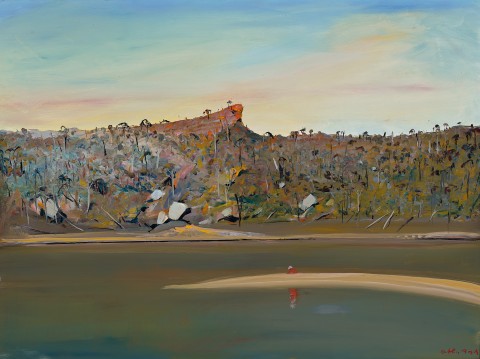PULPIT ROCK, SANDBAR AND FIGURE, SHOALHAVEN RIVER, c.1987
ARTHUR BOYD
oil on composition board
91.0 x 122.0 cm
signed lower right: Arthur Boyd
bears inscription verso: 4
Wagner Art Gallery, Sydney
Private collection, Sydney, acquired from the above in November 1989
Estate of the above
‘...The river itself, of course, is the most compelling image in many of these paintings of this period. Boyd has captured it in all its moods; quiet as floods begin to recede; ugly brown as it swells with water; dark, calm and green in summer when the land is parched; glowing pink at sunset.’1
Eager to rediscover his roots, his ‘Australianism’, after more than a decade abroad, in 1971 Arthur Boyd returned to the country of his birth to take up a Creative Arts Fellowship at the Australian National University in Canberra. Over the blazing summer of 1971 – 72, Boyd and his wife Yvonne were invited by the Sydney art dealer Frank McDonald to visit Bundanon for the weekend, staying at a home he shared on the south coast of New South Wales with art historian Sandra McGrath and her husband Tony. Here the artist’s joyful rediscovery of the Australian bush with its stark contrasts and clarity of light was nothing short of an epiphany, and thus in 1973, Boyd purchased the nearby property Riversdale on the banks of the Shoalhaven River. Once again, the magic of the dour, untamed Australian landscape became the impetus for his art, and over the subsequent twenty-five years until his death in 1999, Boyd would dedicate himself almost exclusively to immortalising the myriad moods of the Shoalhaven in images that are today imprinted upon the national psyche as some of our most beloved and iconic.
Featuring the magnificent Pulpit Rock towering above a lone figure nestled on the sandbar below, Pulpit Rock, Sandbar and Figure, Shoalhaven River offers a powerful meditation upon the immense physical presence of Nature. A central feature of the Shoalhaven paintings executed during the eighties, this monolith, with its distinctive forward-tilting Phrygian cap profile, has been variously described by scholars as Boyd’s ‘…Rigi, his Mount Fuji, his Mont Sainte-Victoire’2 (alluding to the great mountain sequences of J.M.W. Turner, Hokusai and Cézanne), and perhaps more abstractly, compared to the haystacks and Rouen Cathedral scenes that occupy Monet’s oeuvre. Indeed, elaborating upon the religious significance imbued in his repeated use of this motif, Hoff suggests ‘in these paintings of Pulpit Rock set between sky and water in an ambience of luminous space, Boyd restates the theme of the cyclic element in nature that had occupied him in the forties.’3
Acknowledging that he is religious ‘in the sense that I am overawed by the marvellous things in the world and overawed by the awful things’,4 thus Boyd here pays homage to the grandeur and sheer beauty of Nature – all the while implying that unless steps are taken to preserve this wilderness for future generations, it will be destroyed. As Janet McKenzie elaborates in her monograph dedicated to the artist’s Bundanon period, ‘The natural beauty of the Shoalhaven area caused Boyd to marvel constantly. His paintings are a celebration of grandeur and wonder of Nature. It is to Boyd’s credit that a single landscape can inspire such diversity of work. He gives us the impression that there are infinite possibilities, as long as we train ourselves to see.’5
1. McGrath, S., The Artist and the Shoalhaven, Bay Books, Sydney, 1982, p.78
2. Hoff, U., The Art of Arthur Boyd, Deutsch, London, p. 78
3. ibid.
4. Boyd, cited in McKenzie, J., Arthur Boyd at Bundanon, Academy Editions, London, 1994, p. 43
5. ibid., p.42
VERONICA ANGELATOS
